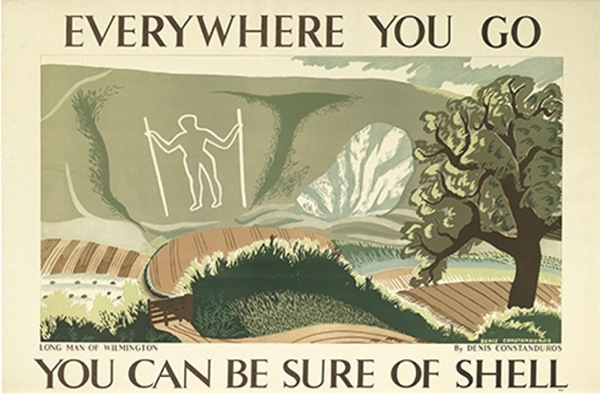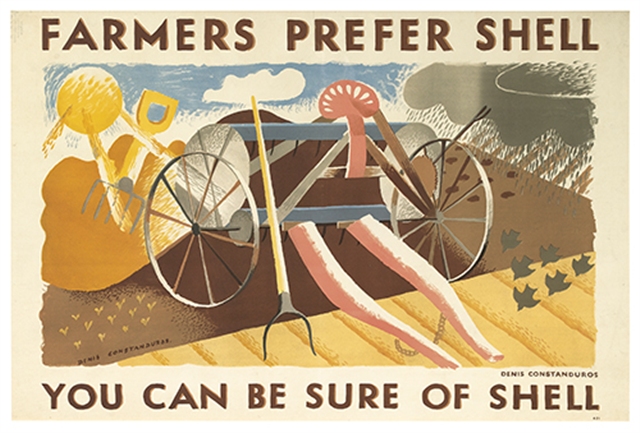Today, I’m turning the blog over to the floor, because there have been lots of interesting comments recently. Some of them are thought-provoking enough to need whole blog posts in reply (like yesterday’s). But there are also plenty more which deserve attention too. So here goes.

Hans Unger, GPO, 1954
Firstly, the post on Hans Unger and his life attracted an evocative reminiscence from D.E., which I definitely didn’t want to leave languishing at the bottom of an old post from last month.
I lived in Hans’s house in Muswell Hill with my parents from shortly before his death until the late 70s. Hans rented us the upstairs of his semi-detatched, furnished the whole place for us all the way down to the linens, plates, and cutlery, and was very kind. My mum, herself a Jewish escapee from Nazi Europe, and an artist, marveled at him and his work. It wasn’t long after we moved in, sadly, that we became concerned at not seeing him for a few days, and… well… led to his discovery with a bottle of sleeping pills by his bedside, with a goodbye note. Needless to say, shocking for a 14 year old. Still, we stayed in the house for about 4 more years, and had Hans’s giant outdoor mosaic to look at in the back yard, the stained glass over the front door, and several of his LT posters scattered throughout the house.
Hans’s spirit was complemented well by the woman who moved into the lower part of the house afterwards. I believe that she knew Hans, and herself was a Jewish South African illustationist – Lixi Darvall. She filled the house with art and laughter, but sadly, she too died while we lived there, in her case from cancer.
I remember the house well, full of art and artists, and of the odd collection of Jewish survivors, and am fond of all those creations by these wonderful people.
It’s wonderful to hear him remembered as a person as well as a designer.

Hans Unger, London Transport (half of pair poster), 1957
But comments can also be corrections, and I was put right after complaining that a whole host of London Transport posters on eBay didn’t look linen mounted to me. I now know that I was wrong, as Martin Steenson told me that old-fashioned linen mountings were often trimmed to the size of the poster. Mike Ashworth gave an explanation of just why these particular posters might have been mounted this way, too.
I suspect many of the posters such as these currently on sale at Ebay have, over time, been released from the spares held by the old LT Publicity stocks by the LT Museum. I recall that many of these ‘information’ posters (rather then pictorial posters) were linen backed so that they could be trimmed and then used on a more semi-permanent basis at offices, stops, etc. A good example would be the LT ‘you are here’ posters (the area maps for tube stations) that were printed in 10s or 20s (as spares/replacements) and that were seldom replaced. The ‘spares’ were released to dealers etc by LTM some years ago and now show face on Ebay and at dealers – they’re often linen backed, either trimmed or not.
We have this one, also linen mounted, and now I know why it is the way it is, so thank you.
Finally, more of an addendum. When I wrote about Denis Constanduros last week, I couldn’t work out whether the artist of the Shell posters was the same man who went on to adapt Jane Austen for the television in the 1960s. It turns out – perhaps not surprisingly given his rather less than common name – that it was.
I found out thanks to the wonder that is our local library system, which lets me order books online from about six different counties around. So, from the depths of the Somerset Reserve Stacks, I called up My Grandfather by Denis Constanduros on the offchance that it might reveal something. I can’t tell you anything about the merits of the book itself yet, but it did contain this biography of Denis himself.
Born in 1910, Denis Constanduros escaped a formal education and had, instead, a succession of private tutors. He was only 15 when he sold his first cartoon caricatures of Wimbledon players and characters to the press. Later, he went to Chelsea Art School and produced Shell posters at the same time as Graham Sutherland and McKnight Kauffer.
At the age of 27, he had his first radio play produced, although he had already collaborated with his aunt, Mabel Constanduros, on some of the Buggins Family sketches.
The mother of Denis Constanduros was a daughter of Richard Tilling of the successful Tillings Transport group. The two daughters married two sons of the Constanduros family. Denis’ father was an unqualified architect and a compulsive gambler, and his mother and father parted company after the First World War.
In 1938, Denis Constanduros married Barbara Neill and moved to Wiltshire. Classified unfit, although he had at one time been mixed doubles champion of Portugal, he spent much of the Second World War working in the office of a munitions factory. in 1948, he had his first television play accepted and My Grandfather was published.
The West Country radio serial Denis Constanduros created and wrote, At the Luscombes ran for 16 years. He adapted many classic novels for television during the 1960s and 1970s, including works by H.G. Wells, Henry James and Jane Austen, and died in 1978.
So now we know. The Shell Art Collection at Beaulieu tells me that he did six artworks for Shell, but I haven’t been able to find images of any of the others. Still, these two are so lovely that I, for one, am very happy to see them again.
Finally, a dilemma, posed by “mm” last week.
I’ve got mixed feelings about all this pre-auction promotion…Of course, if you alert me to something I’ve missed it’s great. But if you alert everyone else to something I’ve spotted and I’m hoping has slipped under everyone elses radar it’s not so good! I’m not sure what the answer is…Only discuss items post auction?
Now I have to admit that I have the advantage here, because if I spot a potential bargain coming up, I do only mention it once the auction has been and gone – as with the Constanduros above. Which means that I can’t really judge this one fairly. Although my personal suspicion is that no one takes the blindest notice of what I write on here, and one of these days I’m going to go back over all of the things I’ve highlighted on eBay to prove this, as I will happily bet that loads of them don’t even get a bid.
But what do you think? Would you rather hear about auctions coming up and take the risk that I might reveal one of your carefully-spotted bargains? Or would you rather I shut up until it’s been and gone? And have you ever gone for something because I mentioned it? Answers in the box below, if you don’t mind.
While I write this, incidentally, the Christies Auction is rattling away in the corner of Mr Crownfolio’s screen and it is officially Going Bonkers, with everything way over estimate. More next week.



Well I bid on Brookshaw’s Bognor Regis BR poster at Dreweatts as a result of reading about it on your blog…Didn’t get it though!
Sorry you didn’t get it – that is a lovely poster.
As I said the other day, I end up bidding on things because I write about them here – I wouldn’t have paid the Polunin poster at Christies much attention normally, but I wrote about it and then decided it was rather interestingly eccentric. But we were totally outbid on that.